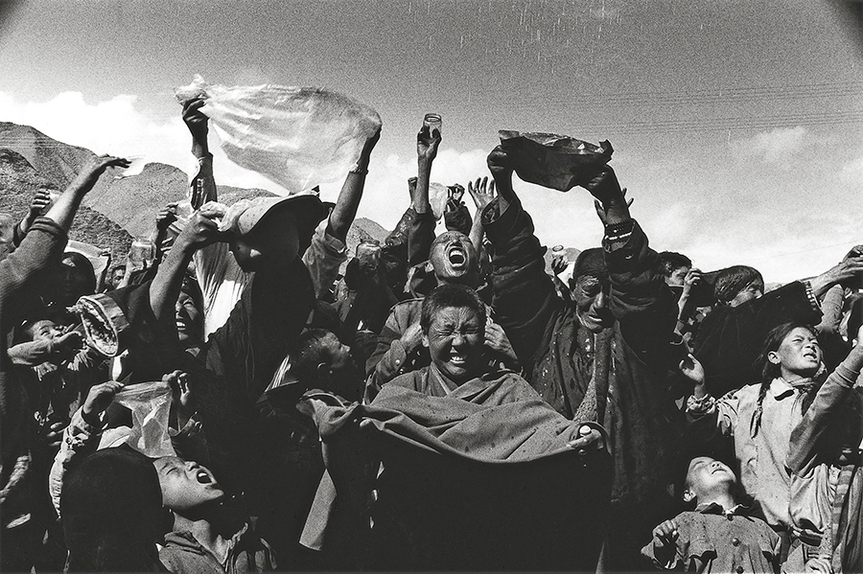
R
E
V N
E
X
T
The Salt Yard, an independent art space in Hong Kong dedicated to photography, closed in the spring of 2015 after a short two-year operation. However, The Salt Yard continues to run its online store, specializing in photo books by independent photographers and publishers. For its first project since the closure of its gallery last year, The Salt Yard will be launching a new photo book titled Vajrayāna by acclaimed Hong Kong photojournalist Kan Tai Wong on June 10 at Comix Home Base in Hong Kong’s Wan Chai district with an artist talk and sharing session.
Wong’s adoption of the title Vajrayāna for his book represents a culmination of over two decades of photographic works documenting the Tibetan diaspora, which included Tibet, Nepal, India and Sri Lanka. The word Vajrayāna originated from Sanskrit meaning “diamond vehicle,” referring to a form of Tantric Buddhism practice developed in India and its neighboring countries, most notably in Tibet.
Born in Hong Kong’s Lantau Island in 1957, Wong was given his first opportunity to take up photography in 1977 when he joined Wen Wei Po—a longstanding local Chinese newspaper—as a reporter. He had to learn photography quickly and work briskly to ensure that he had the photos needed for the story, for the unpredictable nature of breaking news rarely offered a second chance. By 1980, he was promoted to the role of a full-time photojournalist and was no longer confined to breaking news only. In 1982, perhaps feeling restless and eager to increase his knowledge of his trade, he enrolled in the photography program at the Tokyo Polytechnic University.
Upon his return to Hong Kong after his four years in Japan, Wong rejoined Wen Wei Po. In spring of 1989, while on assignment for a sports feature in Beijing, he became one of the first witnesses to the nascent stirring of the student protest movement taking place at Tiananmen Square. During this period, Wong made the decision to take a long-term leave from the newspaper and devoted himself entirely to observe and capture what he considered to be one of the most significant chapters in modern Chinese history. The result of this work was ’89 Tiananmen published in 1990, and re-published with additional images in 2011. Among some of his other publications are Beijing Story (1999) and Hong Kong Walled City: 2002-2007 (2007).
After leaving Wen Wei Po in late 1990, Wong became a freelance photographer and in May of 1991, he set foot on the high plains of Tibet. Drawn by its inhabitants and their religion, the mysterious aura and the desolate remoteness of its landscape, Wong was greatly affected and would return many times to Tibet in the next 20 years. In a recent conversation with ArtAsiaPacific, Wong commented that it was perhaps the freedom from the pressure of newspaper deadlines that led him to feel he could approach Tibet with a much more personal and intuitive form of photography. Wong admires the works of Czechoslovakian photographer Josef Koudelka and Swiss-born photographer Robert Frank, citing photography books such as Koudelka’s Gypsies (2011) and Frank’s The Americans (1958) as his influence. Wong began approaching his photography with less of a pre-conceived mindset and with more of the intuition he felt from his heart.
In our conversation, Wong further explained the change in his approach: his perspective on photo documentation can basically be divided into two ideals, the window and the mirror. While the former looks through the window and records what is in front, the latter is trickier in which one wishes to reflect visually on what one comprehends, and feels what’s in front of him from a totally subjective point of view, and hopes that in the end this will be shared by the viewer.
Looking through a freshly printed copy of the book I was struck by its distinctly unique vision and honesty in each of the frames; the manner in which they are juxtaposed and sequenced was clearly edited with utmost care and consideration. While some of his compositions may at times lead one to think that they were taken seemingly random, like snapshots, with no apparent focus, this was indeed not the case. Wong’s choice of black-and-white film with discernible grains accentuates the harsh and desolate landscape; his deliberate underexposure, rendering figures in silhouette, reminds us of the closeness of the sun and adds a mysterious aura to its inhabitants. Similarly, images from inside the temple are dark and taken with a slow shutter speed, catching blurry monks with fleeting long robes in motion, evoking an emotive sense of impermanence.
At the heart of the book Vajrayāna is Wong’s personal reflection on the spirituality of the Tibetan people, we feel the plight of this isolation through his vision. When asked what his next project might be, Wong answered unhesitatingly that Vajrayāna is only the beginning of a long journey and much more still needs to be done.
Billy Kung is photo editor at ArtAsiaPacific.



